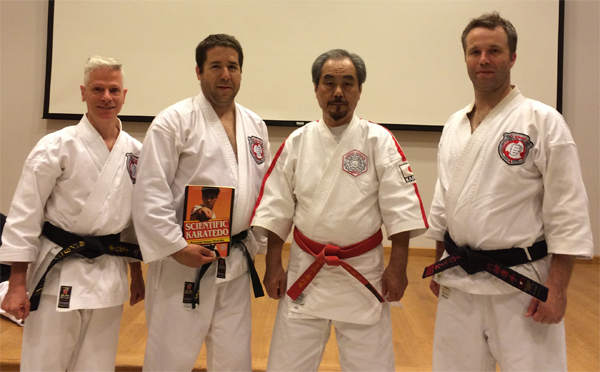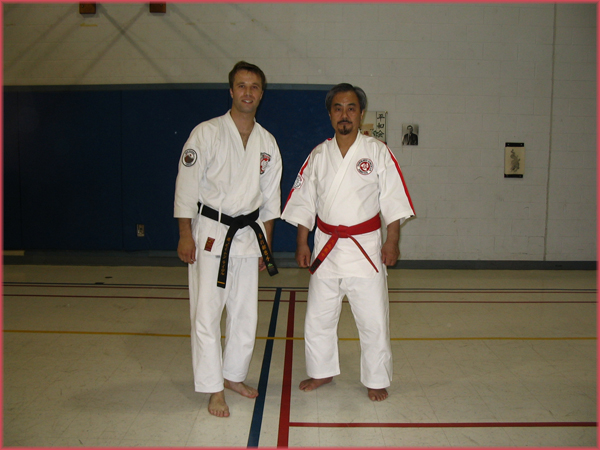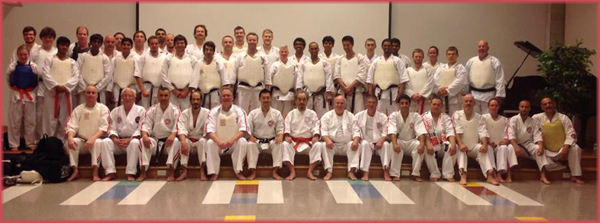2014 Shorinjiryu Karate Seminar with Hanshi Masayuki Hisataka

In June 2014, three of our members from Zen Fight Club—Sensei George Rigby, Sempai Dany Lapointe, and I—travelled from our nation’s capital in Ottawa to the beautiful campus of Western University in London, Ontario, to participate in a comprehensive seminar offered by world-renowned karate master Hanshi Masayuki Hisataka, 9th Dan.
We were able to put the politics of the various factions within Shorinjiryu Karate-do aside, which are not unlike other major styles of karate and martial arts, and enter the seminar with an open mind to learning, or as Bruce Lee said, “an empty cup,” for which we were generously rewarded.
Hanshi Hisataka immediately established his authority, critiquing nearly everyone’s form, regardless of their rank. Gradually, he would offer encouragement and praise, but it had to be earned. We were in the presence of a true martial arts master from a high-ranking samurai family, who has trained thousands of students the world over. The experience was profound.
Karate Kata Bunkai
We learned some of the inner secrets of the bunkai (analysis of fighting techniques extracted from a martial arts form) associated with kata koshiki basai and were encouraged to really think for ourselves when interpreting our kata… beyond a series of mechanical movements done for performance. The kata was broken down into three basic elements:
Juho (soft techiques): locks, throws and takedowns
Goho (hard techniques): strikes, punches, kicks and blocks
Bukiho (weapons techniques): defending against the bo staff and boken (wooden sword)
For me, there were many subtle points going back to the roots of our karate style and martial arts in general, for example: the importance of maintaining eye contact with your opponent, as Mr. Miagi said in Karate Kid, “Always look at eye, Daniel San.” We explored the proper use of breath and power and focus during full-contact striking drills, focusing on evade and counter techniques.
During the seminar, we also got to meet and train with karate-ka from across Canada and around the world, sharing in the learning and interpretation from an international perspective.
Back in 2004, I had the opportunity to train with Hanshi Hisataka, when I was a ShoDan (1st Degree Black Belt) and have continued to build on the principles I learned from the master at that time.

Regardless of the political stripes or regional differences within the Shorinjiryu family of karate practitioners, the chance to train again with Hanshi Hisataka was truly a valuable experience. It has re-energized my commitment to learning the depths of Shorinjiryu karate-do.
James Taylor
5th Dan Black Belt
What an amazing experience it was to train with Hanshi Masayuki Hisataka, son of Kaiso Kori Hisataka, who founded Shorinjiryu karatedo.
Hanshi Hisataka first visited Canada as a young man to demonstrate karate at the Japanese pavilion at Expo ’67. He stayed in Montréal for the next seven years, teaching Shorinjiryu karate.
Now over 70, having designed the safety equipment we use to avoid injury in our full-contact sparring and written two books on Shorinjiryu karatedo, he continues to teach in Japan and in countries around the world.
It was an honour to attend four three-hour training sessions with this legendary figure. He could be both stern and patient, critical and encouraging. In his own unique way, he wanted to incite all of us to do our best.
Besides the fascinating new material I learned (kata koshiki bassai and the related bunkai kumite), I gained insight into Shorijiryu karatedo as a complete martial art and, above all, a complete life-path.
I understood more than ever that our style of karate has integrated some of the most effective elements of various martial arts—punching, kicking, gripping and throwing, in addition to effective use of weapons like the bo staff, bokken (wooden sword) and sai (three-pronged dagger).
I also began to understand that we can enhance our technique and our mind by analyzing the forms we learn. By diligently practising correct dojo etiquette, we can develop such qualities as patience, respect and mindfulness.
George Rigby
3rd Dan Black Belt
Last month I attended a two-day seminar in London with Hanshi Masayuki Hisataka, and it was incredibly beneficial for my karate future.
Hanshi Hisataka taught us the bunkai (interpretation) of kata bassai. He also encouraged us to think for ourselves and be creative in interpreting kata. Because of my background in traditional jiu-jitsu, I was impressed with how this karate style incorporates throws, locks and striking techniques.
Hanshi Hisataka also took the time to lead us in some good fighting drills using the protective equipment. I like the way our karate style includes many good elements of all martial arts and makes it realistic by allowing us to use full contact. Hanshi Hisataka proved to me that Shorinjiryu karate is a very good martial art in every respect.
Dany Lapointe
2nd Kyu (Brown Belt)
